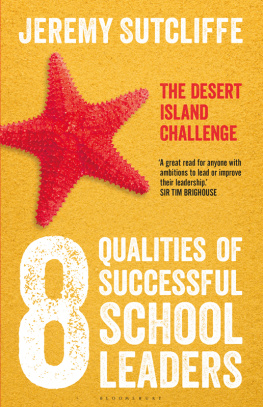8 Qualities of
Successful School
Leaders
The desert island challenge
Jeremy Sutcliffe
Contents
No matter how well-constructed, a building only becomes a school once it is filled with real children and teachers. So it is with this book. Without the many passionate and dedicated school leaders who contributed it would be a hollow shell. Their wisdom, insights, real-life experiences and stories are what, I hope, will bring these pages to life for the reader. This book is dedicated to them.
First and foremost I would like to thank those who took part in my desert island challenge. Their thoughtful, fascinating and often inspiring contributions form the backbone of the book and many of these are reproduced in full, with their kind permission, in Buenos Aires, Argentina; Nigel Richardson, former Headteacher, The Perse School, Cambridge; Lynn Slinger, Headteacher, Forest Way Special School, Coalville, Leicestershire; Paul Smith, Principal, Parbold Douglas Church of England Academy, near Wigan, Lancashire; Bernard Trafford, Headmaster, Royal Grammar School, Newcastle; Teresa Tunnadine CBE, Headteacher, The Compton School, Finchley, London; Madeleine Vigar, Principal, The Castle Partnership Academy Trust, Haverhill, Suffolk.
Secondly, I would like to thank the following leaders for agreeing to be interviewed and sharing their insights: Maggie Farrar, former Executive Director and Interim Chief Executive, National College for School Leadership; Devon Hanson, Principal, Evelyn Grace Academy, Southwark; Sue Hargadon, Principal, Farlingaye High School, Suffolk; Dame Joan McVittie, Headteacher, Woodside High School, Wood Green, London; Ani Magill, Headteacher, St John the Baptist School, Woking, Surrey; Alison Peacock, Headteacher, The Wroxham School, Potters Bar, Hertfordshire; Patricia Scott, Headteacher, St Lukes High School, Barrhead, East Renfrewshire, Scotland; Nicola Shipman, Executive Headteacher, Fox Hill, Mansel and Monteney Primary Schools, Sheffield.
Thirdly, I would like to thank the following for their advice, helpful suggestions and guidance during the books early planning stages: Sir Michael Barber, Chief Education Advisor, Pearson; Andy Buck, Managing Director of Academies, United Learning; Alan Hall, former Headteacher, Immanuel Church of England Community College and Belle Vue Girls School, Bradford (my old English teacher); Geoff Lucas, former Secretary, Headmasters and Headmistresses Conference; Dr Sue Robinson; former Headteacher, Cherry Orchard Primary School, Birmingham; Huw Thomas, former Headteacher, Emmaus Catholic and Church of England Primary School, Sheffield and now Sheffield Diocesan Director of Education.
Having been a working journalist for 35 years (most of it covering education), I have a keen appreciation for the work of editors and am deeply grateful for the help and guidance of Holly Gardner, Anna Fleming, Jane Morgan and David Avital at Bloomsbury for helping to shape and give structure to what began as a half-formed idea composed in an e-mail when I had nothing better to do. Without their efforts the book would not be anything like as accessible as a resource to teachers and school leaders.
Finally, I would like to thank Sue Sutcliffe, my wife and partner in life, who encouraged me to write the book in the first place and greatly helped me with the whole project. Having finished the book, she will no longer be able to compare me to Edward Casaubon in George Eliots Middlemarch. Mark!
Eight key qualities to survive and prosper in school leadership.
What are the qualities needed to be a successful school leader? This is the question that this book sets out to answer. In my quest to find some answers one thing was clear right from the start. There is no simple formula that produces greatness in a headteacher or school principal. The best ones are individuals who know their own minds and have their own ideas. Yes, they are keen to learn from others about what works well elsewhere. They are also curious and enthusiastic about applying great ideas that they think will benefit their own pupils and staff. But they are their own men and women and they certainly are not clones.
So this is not a book that seeks to write a particular prescription for headship. It is not about government-led initiatives, top-down models or politically-directed attempts to change the culture of leadership in our schools. Instead it focuses on the vital ingredients and instincts that successful school leaders say have worked for them. As such, it attempts to sketch a portrait of modern headship, drawn from life. Around 30 school leaders contributed to the book, including more than 20 who agreed to be interviewed. Some work in highly disadvantaged primary and secondary schools while others are in prestigious schools in the independent sector. Many, but not all, are officially recognised as outstanding or excellent leaders by school inspectors and all of them are highly experienced and respected leaders in their profession.
The art and craft of headship
In contrast to many officially-approved publications this book does not attempt to identify 20 or 30 schools that meet fixed criteria for excellence. Nor does it attempt to do the same for the many excellent and splendid school leaders it features. It is not a book driven or determined by school performance data in any shape or form. Rather, it attempts to depict the real art and craft of headship by listening to a variety of very successful leaders working in a variety of different schools and settings. It is these leaders, not me, who have shaped this book and their insights and sound wisdom that I hope will provide a source of inspiration to all school leaders and anyone thinking about moving into headship.
In attempting to identify the key qualities most valued by successful leaders I began by talking to some headteachers I knew well. Some of these including Kenny Frederick, Mike Kent, Geoff Barton and Roger Pope feature prominently in these pages and I am grateful to all of them for helping to shape my approach. I was determined from the outset not to write a dry book about professional attributes and characteristics but one that would spark some lively discussions about the importance of headship and the kind of people we would like our school leaders now and in future to be.
Desert island challenge
My next step was to issue a challenge. To make it interesting I made it a kind of parlour game, based on the long-running BBC Radio Four programme Desert Island Discs. I invited school leaders to imagine they were cast adrift on a desert island with a school full of children in desperate need of a great headteacher. I asked them to consider what eight qualities they would take with them to run their desert island school. I was greatly helped by Maggie Farrar, then Executive Director at the National College for School Leadership, who kindly agreed to relay my challenge to headteachers and principals in the colleges National Leaders of Education network. I am also grateful to Geoff Lucas, formerly Secretary of the Headmasters and Headmistresses Conference (HMC) who generously offered to publish it in the associations newsletter. This brought correspondence from some surprising places, including from heads of international schools as far away as India and Argentina.
The response overall was a positive treasure trove of thoughtful contributions from some very impressive leaders. Their comments and insights form the backbone of this work and many of their contributions are reproduced at the back of this book (). From their replies I began to see some common threads which could be woven into a narrative. But what also struck me was the many different qualities that are required or at least desirable to run a successful school. I found this reassuring as well as fascinating, especially the varying weight given to particular qualities by different leaders. It confirmed my belief that, while there might well be a common set of qualities which leaders agree are important and necessary, there is also scope for many different and distinctive styles of leadership.









